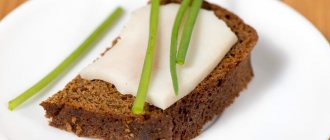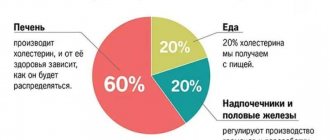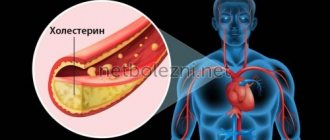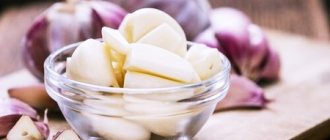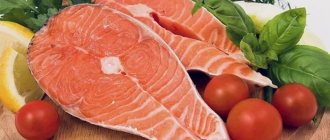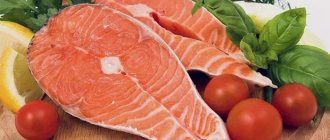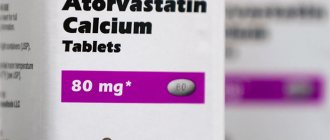Disorders of carbohydrate metabolism, as well as lipid metabolism, are an urgent problem in modern society. The main criteria for this pathological condition are considered to be an increase in the concentration of cholesterol and sugar in the blood plasma.
A decrease in insulin production by pancreatic cells leads to the development of a dangerous disease - diabetes mellitus, which is often accompanied by hypercholesterolemia. Patients with this diagnosis ask their doctor the question: “How to eat to improve metabolism?” A diet for high blood sugar and cholesterol is based on the principles of a healthy diet.
Importance of blood fats for diabetics
People with metabolic pathologies are at risk for developing diseases of the cardiovascular system. Modern scientists see a clear connection between insulin deficiency, elevated sugar and cholesterol levels. Thus, a lack of pancreatic hormone leads to a persistent increase in blood glucose, which in turn causes an increase in cholesterol, with a predominance of its “bad” fractions (LDL, VLDL), and a decrease in the “good” fraction (HDL).
Over time, lipid molecules of low or very low density begin to be deposited on the endothelial lining of the vascular bed, leading to the occurrence of atherosclerosis, as well as the development of complications from the cardiovascular system. Thus, atherosclerosis and diabetes mellitus have a well-founded connection with each other. But with timely identification of these problems, as well as a competent approach to them, it is possible to minimize their negative impact on the body.
What foods lower blood sugar and cholesterol?
Patients with carbohydrate and lipid metabolism disorders constantly ask their doctors the question: “What can you eat if you have elevated glucose and cholesterol levels?” Modern nutritionists say that a diet with high sugar and cholesterol should contain foods that help reduce the concentration of these substances in the blood serum. Food containing special substances - phytosterols , normalizes glycemia and helps fight hypercholesterolemia.
Foods rich in phytosterols include:
- soya beans,
- corn and sunflower seed oil (unrefined),
- sesame seeds,
- nuts (almonds, pistachios, walnuts),
- indirectly pressed rapeseed and olive oils,
- buckwheat grain,
- broccoli,
- avocado pulp.
Prohibited foods and dishes
A diet for high sugar and cholesterol implies the exclusion of foods and dishes that negatively affect these indicators. In case of diabetes mellitus and hypercholesterolemia, it is forbidden to eat fatty meat, sausages, lard, sweets, baked goods, fatty cheeses, carbonated drinks, bananas, foods with a high starch content, high-fat dairy products, excessively strong tea, coffee, cocoa with added Sahara.
The method of heat treatment used to prepare dishes is of great importance It is recommended to boil dietary food, bake in the oven or grill, steam, or stew. When frying, the calorie and fat content of dishes increases significantly, which is unacceptable for dietary nutrition. When preparing compotes, fruit drinks, and decoctions, it is not recommended to add white sugar. To sweeten the drink, you can add a little honey.
Metabolic disorders, the main manifestations of which are increased serum cholesterol and sugar, are not a death sentence. If pathology is detected in a timely manner, in order to normalize the indicators, it is enough to adhere to the principles of dietary nutrition, as well as other medical recommendations.
It is advisable to regularly donate blood to determine its sugar and cholesterol levels. These simple measures will help maintain health and increase life expectancy!
As diabetes mellitus progresses, the metabolic processes of carbohydrates are disrupted in patients. This pathology occurs when there is a lack of insulin production or a lack of receptor sensitivity to this hormone.
As a result, glycemia develops, so patients' glucose levels increase. The walls of blood vessels are gradually destroyed in the body. To normalize the indicators, you need to limit the consumption of harmful foods. A sharp increase in glucose leads to serious disruptions in the functioning of internal organs.
What can you eat
The diet includes a fairly wide list of permitted foods. However, it is very important to know the calorie content of dishes in order to control fat and carbohydrate metabolism. This helps prevent the development of vascular complications: atherosclerosis, liver and kidney dysfunction.
Authorized products:
- The basis of the diet is vegetables: tomatoes, peppers, eggplants, pumpkin, zucchini, cucumbers, cabbage (fresh, pickled), garlic, onions, ginger. Legumes are allowed: lentils, peas, red beans. Vegetables are boiled or stewed. 3-4 times/week can be served baked.
- Greens: parsley, celery, dill, cilantro, green onions.
- Fruits, berries: grapefruit, lemon, cranberries, currants. Consumed fresh. Apples, tangerines, oranges are eaten no more than 1 piece per day. It is not recommended to replace with freshly squeezed juices based on them. You can prepare fruit drinks and compotes. Sorbitol is used instead of sugar.
- Bread made from wholemeal flour, with bran. Recommended dosage: up to 200 g/day.
- It is advisable to cook the first courses in meat or vegetable broth. Okroshka and mushroom soup are allowed.
- Lean meats, chicken (without skin). The meat is boiled or stewed to reduce calorie content.
- Fish can be eaten every day. If you have high cholesterol and sugar, it is better to eat fatty varieties of sea fish: salmon, salmon, pink salmon.
- Whole grain cereals: buckwheat, pearl barley, egg, rolled oats. The amount of cereal is limited to 8-10 tbsp. l./day
- Low-fat fermented milk products: kefir, yoghurt, sour cream (added only to ready-made dishes).
- Vegetable oils: olive, sunflower, corn. Norm – 1 tbsp. l. /day.
- Unsweetened drinks or with sugar substitutes: black, green tea, vegetable juices, chicory. Decoctions of blueberry stems, strawberry leaves, rose hips, bean pods, and nettles are very useful. They help normalize sugar, cholesterol, and improve the condition of blood vessels.
For diabetes and high cholesterol, there are foods whose consumption should be limited to 2-3 times/week:
- Boiled or baked potatoes. It contains a lot of starch and is high in calories, so it is eaten no more than 200 g in all dishes.
- Low-fat cottage cheese, cheeses with fat content up to 30%, milk. The products contain animal fats, sugars, and large amounts of carbohydrates.
- Semolina porridge, white rice, and pasta are introduced into the diet occasionally. They should not be combined with meat, chicken, or bread.
- Egg yolk contains about half the daily value of cholesterol. Therefore, when consuming it, you should calculate the amount of sterol coming from other products. Egg whites can be consumed unlimitedly.
- Although beets and carrots are useful for high cholesterol, they are consumed limitedly in case of high sugar levels due to their high carbohydrate content.
While following a diet with high sugar and cholesterol, you can spend fasting days. The simplest option is protein: kefir, cottage cheese, egg whites, fish. Drinks only include water. You cannot go hungry during fasting days.
Diet rules
A diet for high cholesterol and sugar is similar to the rules of a healthy diet. Patients should adhere to the following advice:
- fractional small portions;
- the diet should contain fiber;
- You can eat fish no more than twice a week;
- exclusion of products that contain sugar;
- It is prohibited to consume fast food.
When following a diet, it is important to organize the correct sleep and rest schedule. Reducing cholesterol has a positive effect on the patient’s well-being. You need to sleep at least 8 hours at night. Prepared foods should be eaten fresh.
Recommendations for proper nutrition for high cholesterol and sugar
As you age, you need to adjust your diet so that foods help keep your sugar and cholesterol levels low. This is an excellent option for the prevention of pathological changes in the body, disruption of blood vessels, as well as the development of arterial hypertension.
Sweets should be replaced with dietary products that were created specifically for diabetics. They contain sweeteners of natural origin. They are also synthetic. It is recommended to combine the combined diet No. 9 and No. 10 according to Pevzner.
Patients can consume no more than 250 g of carbohydrates daily. They are found in vegetables, black bread, unsweetened fruits, and cereal porridges. Proteins should come from fish, eggs, seafood, low-fat cottage cheese, and dairy products. In old age, it is recommended to reduce the amount of meat consumed.
Also limit your fat intake. The maximum daily norm is no more than 60 grams. Most of it should come from plant products. If the patient regularly experiences high blood pressure, as well as decompensation of the heart, it is necessary to exclude salt intake from the diet.
Table of cholesterol content in foods
The highest concentration of cholesterol enters the human body through meat products, cheeses, and animal fat. When planning your daily diet for the week, you need to consider which foods lower sugar and cholesterol, and which lower it. You can use a table for this.
Diabetics only need to know about foods that lower cholesterol and blood sugar, but also take into account the method of preparing them. It is recommended to use stewing meat and fish because the fibers of the structure absorb oil during the frying process. With this treatment, the products will reduce the level of substances and normalize the condition. Do not overuse products of plant origin. They also cause stimulation of excess production of your own cholesterol.
Healthy foods
Most patients suffering from high cholesterol in the blood are overweight and have concomitant diseases such as diabetes, pathologies of the thyroid gland, heart and blood vessels. Also, obese people often suffer from pressure surges. To reduce the negative manifestations of these diseases, obese patients are advised to consume foods to lower cholesterol and burn their own fat tissue.
Water
This is the most affordable, but excellent remedy in the fight against cholesterol. Thanks to the consumption of water, metabolic processes in the body improve, metabolism accelerates, and fat is burned. If water enters the body in insufficient quantities, the excretory system cannot fully perform its work. For this reason, part of the accumulated toxins, waste and harmful substances enters the blood.
People who drink 2-2.5 liters of clean water daily reduce the risk of sludge in the body and the deposition of fat reserves
In response, the body tries to neutralize the poisoning on its own by storing fat for future use. And, conversely, with a lack of natural fluid, general weakness is noted, swelling appears, and the process of urine excretion is disrupted. Long-term use of diuretics leads to the leaching of beneficial substances from bone and muscle tissue, so it is necessary to treat not the effect, but the cause of the disorders.
Rice cereal
What foods remove cholesterol from the body? First of all, doctors talk about the benefits of regular consumption of cereals. Unpolished rice helps to get rid of extra pounds, cleanses blood vessels and intestinal tissues of harmful substances. Rice cereal is a fiber that swells when it enters the intestines, absorbing excess water and increasing calcium and magnesium reserves.
Thanks to the consumption of rice, you can not only reduce the level of cholesterol in the blood, but also improve the regulation of phosphorus-magnesium metabolism and improve the condition of the cardiovascular system. However, this only applies to unpolished rice, while instant cereals do not have any beneficial properties.
Dairy products
Products that lower blood cholesterol include fermented milk. To improve the functions of blood vessels, cleanse them, increase tone and elasticity, a person should receive a daily serving of fermented milk food - cottage cheese, kefir, fermented baked milk, yogurt or yogurt. Lactic acid, which is contained in the listed products, stimulates the activity of the stomach and intestines, improves metabolic processes, makes blood vessels and even the skin more elastic.
If you have high cholesterol, nutritionists advise giving up fatty foods, including fermented milk. However, buying skim milk, cottage cheese or kefir will not benefit the body, and can even be harmful, since many of these products add special artificial substances that help reduce calories.
Garlic
The specific organic compounds contained in garlic increase immunity, fight microbial flora, and slow down the growth of pathogenic bacteria in the stomach. In addition, the root vegetable reduces blood cholesterol levels by 8–10% if you consume at least 1 clove per day, and preferably 2–3.
This root vegetable must be present in the diet of people suffering from high cholesterol levels.
In terms of getting rid of excess fat, the product is also effective because it improves metabolic processes. Garlic is consumed in crushed form as a seasoning for first and second courses and vegetable salads.
Green tea
This drink has long been appreciated by people around the world who want to lose weight, rejuvenate and improve their body health. Green teas contain 6 types of catechins - these are substances that have a beneficial effect on all organs and systems. Thus, epigallocatechin helps cleanse the vascular system throughout the body, improves cardiac activity, and reduces cholesterol and triglycerides in the blood.
Additional confirmation that green tea is good for the heart and blood vessels is official statistics. In China, people suffer from cardiovascular diseases much less often because they drink 6-8 cups of this drink per day.
Coffee
Among the foods that quickly lower blood cholesterol levels, the most controversial is black coffee. Many doctors recommend that patients avoid the drink altogether, since it contains a large amount of caffeine. But the harm to the nervous system and blood vessels is not based on caffeine, but on cafestol, a substance released from the beans during repeated boiling.
For example, espresso is prepared by repeatedly brewing a portion of coffee, which is why the volume of cafestol in it increases significantly, and the substance is harmful to blood vessels. Instant coffee or ground coffee, but brewed only once, stops the development of cerebral vascular pathologies, helps remove excess cholesterol from the body and even reduces the risk of Alzheimer's disease.
Experts believe that a small amount of natural coffee daily helps strengthen the blood barrier, which protects the nervous system from harmful substances carried throughout the body through the bloodstream.
Grapefruit
This fruit contains a lot of pectin, plant proteases, fiber and organic compounds that are useful for many systems of the human body, in particular the liver. Regular consumption of grapefruit has the following effects:
Herbs to lower cholesterol
- lowering blood cholesterol;
- burning fat mass;
- acceleration of metabolic processes;
- fight against microbes, viruses and fungi;
- strengthening the immune system;
- reduction in total sugar.
The fact that grapefruit helps lower sugar and cholesterol levels confirms its effect on the body. Doctors advise eating one fruit at a time when you have a cold, during the recovery stage, or during excessive mental and physical stress. A person who regularly consumes grapefruits notices the disappearance of headaches, fatigue, improved mood and overall well-being.
A pineapple
Cholesterol-lowering foods definitely include pineapples. This product is rich in vitamins, microelements and substances that dissolve the accumulation of cholesterol on the vascular walls. Pineapple fruits help burn fat tissue, which is taken into account by manufacturers of various weight loss products that are in demand among women.
Why do many women like to go on pineapple diets? The components of the fruit break down fats, the pleasant taste gives a feeling of fullness, although the pineapple itself does not contain many calories. In addition to suppressing appetite and reducing body weight, the fruit helps strengthen intestinal function and naturally cleanse the body of toxins.
Bromelain is an organic substance of plant origin that has an anti-inflammatory effect, due to which blood vessels become stronger, are less susceptible to damage and accumulate cholesterol deposits on the walls.
Kiwi
It has been established that kiwis effectively reduce cholesterol in the blood, cleanse blood vessels from accumulations of harmful substances, and make capillaries elastic and less brittle. What causes this effect? Doctors have long begun to call kiwi a storehouse of vitamin C, along with lemons and oranges.
Regular consumption of fruit, 2-4 pieces per day, will significantly improve the well-being of any person
Ascorbic acid strengthens the walls of damaged blood vessels, restores their tone, removes minor damage, so that harmful lipids do not accumulate on the inside of the capillaries. Kiwi contains fiber, which improves digestion, magnesium, which stabilizes heart function, and potassium, which lowers blood pressure.
Enzymes and collagen, which kiwi fruits are rich in, help burn excess fat, improve the condition of facial skin, hair and nails, which is very important for women.
Papaya
It is very useful for women who want to lose weight and get rid of excess cholesterol in the blood to eat papaya regularly. The fruit contains a huge amount of vitamins, nonspecific lipases and macroelements that promote fat burning and break down harmful lipids entering the body.
You can eat papaya fresh or dried; it retains its beneficial properties. To achieve low cholesterol levels, the healthy fruit should be consumed before meals. This way you can activate the substances contained in papaya for enzymatic action and breakdown of food entering the body.
Raspberries
If your blood cholesterol and total sugar levels are high, fresh raspberries will help reduce these levels. The berry is rich in ascorbic and malic acids - they are involved in the process of cell respiration, strengthening capillaries, increasing their elasticity and tone. How do raspberries lower cholesterol and burn fat?
Carbohydrates are converted first into organic acids, and then into water and carbon dioxide; in the process of such transformations, malic acid is formed, which accelerates metabolism and dissolves excess fat. How else can raspberries help lower cholesterol? The berry contains fiber, which improves the functioning of the gastrointestinal tract, which is very useful for people with constipation. As a result, the body is cleansed of waste, harmful substances and toxins.
Thanks to coumarins, the process of blood clotting is normalized, it becomes more fluid, and the risk of formation and separation of blood clots is prevented. Anthocyanins help strengthen vascular walls, increase capillary tone and prevent atherosclerosis. Vitamin P additionally provides blood vessels with the ability to resist and resist the formation of microscopic cracks in the walls.
Sample menu of a hypocholesterol diet for a week
To plan your own meals and not eat prohibited foods, you can use the ready-made recommendations of the compiled menu for the week. It looks like this:
| Day of the week | Breakfast | First snack | Dinner | Afternoon snack | Dinner |
| Monday | Oatmeal with water or milk, one fruit of your choice | Vegetable salad with low-fat sour cream dressing | Soup with light chicken broth (you can add rice or buckwheat) | Kefir with the addition of a teaspoon of chopped fiber | Fresh vegetable salad. For dressing: lemon juice or vegetable oil |
| Tuesday | Curd pudding, herbal decoction of chamomile | Natural juice | Vegetable soup without broth, chicken cutlets | Berry jelly, rice cakes | Baked fish with vegetables |
| Wednesday | Steamed omelette, chicory | Vegetable soup with cereals | Steamed turkey, vegetable stew | Ryazhenka with added natural fiber | Cottage cheese without salt and sugar |
| Thursday | Pearl barley porridge, rosehip decoction | One fruit | Light broth soup, stewed meat with vegetable side dish | Fruit smoothie made from fruits or vegetables (you can add celery, beets, carrots, wild berries, apples) | Dried fruit compote, fresh vegetable salad |
| Friday | Curd pudding with raisins or other dried fruits | 2 boiled eggs, fresh apple or pear | Vegetable soup, stewed meat in sour cream | Fruit jelly, whole grain bread | Seaweed salad, herbal tea |
| Saturday | Buckwheat porridge, green tea | Baked apple and honey | Seafood soup, vegetable salad | Cottage cheese with greens | Protein omelet with spinach, green tea |
| Sunday | Oatmeal, coffee drink | Fresh apple | Milk soup, vinaigrette | Fruit smoothie made from pears, apples, plums, peaches | Steamed vegetables, pepper, dried fruit compote |
Recipes for a hypocholesterol diet
It is quite easy to diversify the menu during a hypocholesterol diet, since there are quite a lot of foods that are allowed to be consumed. For daily use, such popular dishes as: okroshka, only instead of sausage you can cut boiled chicken fillet or lean veal, vegetable stew with rabbit, risotto with mushrooms and vegetables, cheesecakes, seafood salad, gazpacho, pilaf with dried apricots and prunes and much more. other delicious dishes.
Syrniki
To prepare such a tasty and healthy dish you will need:
- low-fat cottage cheese - 300 grams;
- semolina - 2 tablespoons;
- flour - 4 tablespoons;
- egg white - 2 pieces;
- soda - 1 teaspoon.
Beat the whites with a small amount of sugar, add grated cottage cheese. Then add flour, soda and semolina to the mixture and stir until a homogeneous consistency is obtained. Spoon the resulting mixture onto a baking sheet lined with foil or parchment and cook in the oven at 180 degrees for 15 minutes.
Gazpacho
Gazpacho is a cold Spanish soup made from pureed raw vegetables. To prepare it you will need:
- large fleshy tomatoes - 3 pieces;
- cucumber - 1 piece;
- sweet bell pepper - 1 piece;
- white bread - 1 slice;
- garlic - 2 cloves;
- olive oil - 1 tablespoon;
- salt;
- spices;
- ice.
Place the tomatoes in boiling water for a few seconds to make it easier to remove the skin. Soak the bread in warm water. Peel the vegetables and place in a blender along with the bread. Grind everything until you obtain a homogeneous puree-like consistency. Place on plates, add olive oil and herbs. In summer, it is recommended to add a little ice to this soup.
Sweet pilaf
To prepare such an easy and tasty dish you will need:
- brown rice - 250 grams;
- dried apricots - 200 grams;
- carrots - 1 piece;
- prunes - 100 grams;
- apple - 1 piece.
Rice must be boiled before cooking. Cut the apple, carrots and dried fruits into small strips. It is advisable to pre-soak dried fruits for a few minutes. In a cauldron, fry chopped dried fruits, carrots and apples, add boiled rice, stir. Add water and simmer until it evaporates completely.
Recipes for high cholesterol
Recipes for high cholesterol should consist of healthy foods. This pathological condition in men and women leads to the development of serious diseases. You need to cook dishes without adding vegetable oil. It helps lower cholesterol. It is recommended to use this type of processing - steam, stewing, grilling.
Below are proven recipes that will help normalize cholesterol and glucose in women and men:
- Avocado and vegetable salad. This dish attracts with its taste, festive appearance and rich taste. To prepare the salad you need to take 2 ripe avocados, bell peppers, lettuce, 1 cucumber, 2 stalks of celery, olive oil. Additionally, you can add a teaspoon of lemon juice and fresh herbs. All ingredients must be chopped into cubes and the vegetables must be peeled. In a separate glass, combine oil and lemon juice. They are poured over the vegetables and mixed thoroughly. The greens are washed, finely chopped and sprinkled on the salad.
- Cabbage salad. It can be prepared from white cabbage. This is a proven folk remedy for high blood cholesterol. Cabbage helps remove toxins from the body. As a result, the functioning of the digestive system improves. For preparation use white cabbage, carrots, onions, apples, olive oil and fresh herbs. You can add a pinch of salt. The cabbage is cut into strips, the onion is chopped into half rings. The apple is cut into small cubes, after cutting out the middle. Place all crushed ingredients in a deep bowl and mix thoroughly. Be sure to add olive oil and salt. Greenery is used as decoration.
- Chicken soup with buckwheat. Rich and fatty broths are prohibited from being consumed by people whose cholesterol levels in the body are too high. Chicken broth contains beneficial substances. The main condition is to prepare it correctly so that the composition contains a minimum amount of cholesterol. First, boil one medium breast. The first broth must be drained, the empty pan is rinsed from foam and the chicken breast is added again. It is brought to readiness over low heat for about 1 hour. Next, add chopped potatoes, onions, and carrots to the water. The chicken breast is removed from the broth and cut into cubes. 5 minutes before readiness add a little salt and fresh herbs. You need to eat the soup fresh.
A variety of dishes can be prepared from permitted products. The main condition is the use of a minimum amount of vegetable oil and the absence of fatty broths. These recipes will be useful at different ages - men, women, girls and children.
How to reduce cholesterol with diabetes: list of products
In order to quickly normalize fat and carbohydrate metabolism, it is desirable that the diet be dominated by foods that reduce the level of glucose and low-density lipoproteins.
These include:
- Decoction of blueberry leaves. 1 tsp. fresh raw materials (or 2 tsp dry) pour a glass of boiling water and leave for 15 minutes. Drink three times, consume half an hour before meals. Drink straight. Duration of treatment is 1 month.
- Cucumber juice contains a natural analogue of insulin. Reduces appetite, improves metabolism, has a mild diuretic effect. Saturates with potassium and magnesium, which is beneficial for the cardiovascular system. Freshly squeezed juice is drunk on an empty stomach, 1 glass, 1 time/day.
- Buckwheat is a valuable product that effectively reduces glucose levels. Dry cereals are washed, dried, and ground with a coffee grinder. 2 tbsp. l. powder is poured into a glass of kefir, left for 8-12 hours, and drunk before meals. The course of treatment is 14-30 days.
- Earthen pear (Jerusalem artichoke) improves heart function, restores blood vessels, and reduces sugar levels. Very useful in its raw form. It is recommended to add it to salads and side dishes. You can dry the roots, grind them with a coffee grinder, take 1 tsp. powder in the morning. Treatment lasts 4-6 months.
- Cabbage juice has strong hypoglycemic properties, helps remove toxins, dangerous cholesterol, and cleanses blood vessels from atherosclerotic plaques. If you have diabetes, it is best to eat cabbage salads daily. The juice does not have such a strong effect.
- Black radish juice reduces cholesterol and sugar levels, improves kidney and gall bladder function. The root vegetable is grated and the juice is squeezed out through cheesecloth. Drink 1 tbsp. l. once a day in the morning after meals. The course of treatment is 14 days.
Zinc is considered one of the main elements that normalizes glycemic levels. Most of it is found in boiled fish, wheat bran, green vegetables, lentils, almonds, pistachios, and peanuts. But you need to remember that all nuts are very high in calories. Therefore, they can be consumed every other day, 20-30 g.
Authorized Products
When creating a menu for the coming week and developing new recipes, you need to take into account the list of permitted products. This list includes:
- bran bread;
- sea fish;
- lean meat;
- poultry meat;
- cereals and porridges;
- cottage cheese casseroles;
- grilled vegetables;
- legumes;
- dairy products with minimal fat content.
You can eat yogurt. To diversify the menu, it is recommended to buy cheese with up to 40% fat.
Allowed and prohibited dishes
In order to understand how to reduce cholesterol and sugar using food, you need to know what can be used in the menu. Food should be freshly prepared and induce appetite.
Culinary processing - boiling, steaming, stewing in water and baking are allowed.
The following products are allowed:
- Rye bread, crackers, 2 grades of wheat flour. In total, you can eat 300 g of bread per day. Instead of bread, you can use flour products made from whole grain flour or with the addition of bran, which reduce the glycemic index of products.
- You can use low-fat varieties of fish - perch, pike, pike perch, cod, pollock. Seafood that lowers cholesterol should be included in your diet as often as possible. These include mussels, seaweed, shrimp, squid, scallop, and octopus. Once a week you can eat soaked herring.
- Beef, lamb, veal and lean pork are consumed without fat, chicken and turkey - without skin. It is allowed to eat dietary sausage, boiled tongue and cook from rabbit.
- Porridges are prepared from oatmeal, buckwheat, and less often from pearl barley, barley and millet. Cereals are used to prepare casseroles and first courses. Legumes are allowed 2 - 3 times a week.
- It is better to eat vegetables fresh in the form of salads with vegetable oil, herbs and lemon juice. You can also prepare boiled and stewed dishes from zucchini, cabbage, cauliflower, broccoli, squash, eggplant, and pumpkin. Carrots, potatoes, boiled peas and beets are included in the allowed carbohydrate intake. Use no more than 3 times a week
- Dairy products: low-fat cottage cheese, kefir, yogurt without additives and yogurt. You can eat low-fat cheese (up to 40% fat). Sour cream and cream 10% fat are added to ready-made dishes, no more than a tablespoon.
Nutritional Features
Blood sugar and cholesterol rise in middle-aged and elderly people. Therefore, the sooner you start nutritional prevention, the higher the likelihood of avoiding serious complications. The diet of a patient with the so-called metabolic syndrome, which includes diabetes mellitus, obesity, hyperuricemia and the accumulation of low and very low density lipoproteins in the blood, should be varied. You should also stick to small meals. The patient must learn to eat often, in small portions and at the same time interval. This will ensure harmonious regulation of the synthesis and secretion of digestive enzymes entering the gastrointestinal tract to digest food.
Results of a hypocholesterol diet
Best materials of the month
- Coronaviruses: SARS-CoV-2 (COVID-19)
- Antibiotics for the prevention and treatment of COVID-19: how effective are they?
- The most common "office" diseases
- Does vodka kill coronavirus?
- How to stay alive on our roads?
This diet helps to significantly reduce and normalize cholesterol levels in the blood, and also helps improve the condition of blood vessels and the liver. But in order to completely normalize cholesterol levels, diet alone is not enough. It is recommended to take medications prescribed by a doctor, so before “settling” on such a diet, you should consult a cardiologist and nutritionist. The diet is very well balanced, so it can be used throughout life. Thus, having tried this method once and convinced of its effectiveness, you can make such nutrition a way of life. And as a positive addition to such a diet, there will be weight loss and maintaining it at normal levels for quite a long time. In addition to the low-cholesterol diet, it is very good to introduce sports into your daily routine and get rid of bad habits, such as smoking and alcohol. And then you will feel how much your life has changed for the better.
Foods that reduce sugar and cholesterol
The “right” food can become a kind of medicine. For high cholesterol and diabetes, it is recommended to consume the following foods:
- Vegetables. They are useful fresh or as a stew with a dairy component. Among vegetable crops, preference should be given to carrots and curly cabbage. Some patients prefer squash and pumpkin dishes.
- Dietary rye bread.
- Low-fat meats. These include veal, beef, rabbit, chicken, and turkey. The meat is boiled before frying.
- Lean fish. They also eat boiled seafood (shrimp, squid, scallops).
- Milk and sour milk.
- Eggs. It is advisable to limit their number by reducing them to one per day.
- Cereals with milk. It is allowed to eat buckwheat, rice, pearl barley, millet and egg.
- Fruits and berries, fresh and dried. But very sweet fruits should still be limited. These include figs, melon, peach and watermelon.
- Some spices.
- Rosehip decoction.
- Vegetable oil. Olive oil, which is part of the “Mediterranean” diet, is better suited.
Return to contents
Prohibited Products
Prohibited foods on a hypocholesterol diet include:
- various types of sausages, sausages, small sausages, smoked meats;
- fatty meats, offal, as well as duck or goose meat;
- egg yolks, heavy cream, sour cream and cottage cheese, condensed milk and processed cheese;
- butter, coconut, palm oil, lard, animal fats and hard margarine;
- canned fish and other preserves;
- various nuts (peanuts, pistachios, hazelnuts), chips, candied fruits and French fries;
- baked goods, biscuits, rolls, cakes and other confectionery products;
- all types of sugar, chocolate, sweets, as well as marshmallows and marmalade;
- alcohol, strong coffee with cream and cocoa.
Forbidden foods
In case of diabetes and the accompanying increase in cholesterol, triglycerides, low-density lipoproteins and very low-density lipoproteins in the bloodstream, it is prohibited to eat the following dishes:
- Broths.
- Freshly baked bread. Products made from butter or sheet dough are also harmful to such patients.
- Fat meat. These include duck, goose, and some offal of cattle and pigs. Among them are the liver, kidneys, and brain. Such meat sharply increases cholesterol in the blood.
- Fatty fish. This includes river species. It is contraindicated to eat caviar and canned food.
- Hard boiled or fried eggs.
- All legumes.
- Pickles. Pickled or marinated vegetables will not be beneficial for patients with high sugar and cholesterol.
- Some fruits, especially those containing coarse fiber.
- Sauces and spices based on meat, fish or mushroom broth. Mustard, pepper and horseradish are also contraindicated.
Return to contents
Why were they harmful?
Patients demand an explanation for the ban on consuming certain products. There are the following scientifically proven facts:
Chocolate poses a danger to the life of a diabetic patient.
- Smoked meats increase cholesterol. At the same time, some components in them harm the gastric mucosa.
- Fresh bread, pancakes and pancakes stimulate the accumulation of glucose in the bloodstream.
- A coffee drink, especially a sweetened one, gives a sharp surge of sugar.
- Salty and fatty cheeses provoke the accumulation of LDL and VLDL.
- Sweets and even pure chocolate become deadly in diabetes.
Return to contents
What is prohibited to eat
To normalize carbohydrate and fat metabolism, foods containing fast carbohydrates and animal fats are completely excluded from the menu:
- baked goods, confectionery, sweets;
- any dried fruits, sweet fruits: bananas, dates, grapes, pineapple, melon;
- fatty meat, any type of offal, game;
- semi-finished products: sausages, sausages, canned food, dumplings, dumplings;
- fried, smoked, pickled food;
- brewed coffee, alcohol, sweet carbonated drinks.
Dish recipes
A diet for high cholesterol and accompanying diabetes mellitus should be strict, but varied. It is this condition that will allow you to maintain the body in a relatively healthy state without forcing it. A sufficient amount of proteins, fats and carbohydrates must be retained in the dishes to build regenerating cells. Food should also contain mineral salts, which are used to build the musculoskeletal system. Scientists, doctors and food industry workers have developed special recipes for patients with the above diagnosis.
Healthy salads
They can be vegetable or fruit and must contain products that effectively reduce blood glucose and low and very low density lipoproteins. The best option is a spinach and tomato salad dressed with olive oil. The latter contributes to the reverse development of metabolic syndrome. Spinach is enriched with essential vitamins and nutrients to restore the body.
Fish and meat
To reduce the level of glucose and “bad” cholesterol in the blood, it is recommended to consume low-fat varieties. These include rabbit meat, beef, turkey and veal. Among the seafood, you can prepare boiled sea fish or shrimp, if the patient is not allergic to the latter. An excellent delicacy is salmon, which is a natural source of protein and healthy fatty acids.
Other eating habits
In order to lower the concentration of cholesterol molecules, triglycerides and glucose in the blood, you need to give up fast foods, sweet carbonated and alcoholic drinks, margarine and all kinds of preserves and marinades. Alternatives include vegetarian sandwiches, freshly squeezed juices and fruit salads. If a patient has high cholesterol, it is recommended to eat a lot of greens. The latter stimulates the cleansing of the gastrointestinal tract.
Choosing the best oil
Vegetable oil should be present in every person's daily diet, despite the fact that it is a fat. The oil is rich in healthy Omega-3 acids, which are found in fatty fish, but are absent in meat. Thanks to these acids, metabolic processes in the body are normalized, blood vessels are cleansed, cholesterol levels are reduced, and the risk of capillary blockage with lipid plaques is prevented.
List of the most useful oils for lowering cholesterol:
- Olive – rich in monounsaturated and polyunsaturated organic acids, which are quickly absorbed without having time to be deposited on the walls of blood vessels. The liver and kidneys are not overloaded with fats, and the process of burning your own fat starts. Olive oils also reduce the level of inflammatory processes in the body, promote better absorption of vitamins, strengthen the immune system, and improve the functions of the heart and arterial network. To noticeably reduce cholesterol within 60 days, you need to consume 50 ml of olive oil with salads, cereals, and main courses;
- amaranth - produced from the amaranth plant (schiritsa). Contains 67% healthy fatty acids, a lot of vitamins, microelements and antioxidant substances, such as squalene. It is this substance that releases oxygen from cells, reduces the concentration of cholesterol in the blood and cleanses blood vessels of it. Vitamin E restores the tone of capillaries, giving them elasticity. Amaranth oil is used for dressing dishes and salads, but you can also drink it in its pure form, 1-2 tablespoons;
- flaxseed oil – extracted by cold pressing, it retains a lot of useful substances and vitamins, including Omega-3 and Omega-6 acids. Flaxseed oil is actively used in an anti-cholesterol diet, as it improves the condition of the arteries, cleanses them of cholesterol and harmful substances. You can season salads with oil or take 1 tablespoon every morning.
Why do doctors insist that sunflower oil is harmful, although it has been proven that the proportion of cholesterol in it is negligible? Because in most cases it is used for frying food, and if you have high levels of cholesterol in the blood, you cannot fry food. Also, when visiting canteens and cafes, you should avoid fried foods, because many cooks do not change the oil on time, which is why carcinogens accumulate in it.
The high instability of sunflower oil at high temperatures, the tendency to fry something with it and the resulting excess weight gain are the reasons why a person with high cholesterol should avoid it
